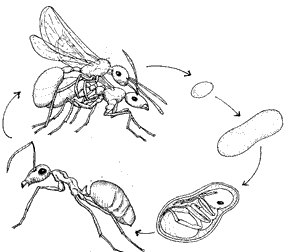Identifying Ants
Ants may be black, brown, or reddish and are 1/16 to 1 inch long. They have elbowed antennae and three pairs of jointed legs attached to their thorax, or "chest." Only males and queens have wings.
The most distinctive structural feature of ants is their thin waist, called a pedicel, which connects their thorax to their abdomen (the large bulbous “tail”). The distinction between the two main groups of ants is that red ants have a single joint in their waist and stinging ants have a two-jointed waist and a stinger at the end of their abdomen.
Ants are social--like wasps and bees to whom they are related. They live in large cooperative colonies composed of two or more generations. The adults are divided into castes, specialized groups that perform certain tasks. Members of the reproductive castes are the queens and males, and those of the nonreproductive castes are the workers and, sometimes, soldiers.
Ant Growth Stages
 |
A new colony usually begins when a mated queen drops her wings and digs a nest or sets up housekeeping in a cavity or in soil under a stone, log or some other shelter in the yard. The queen’s primary job is laying eggs, but after establishing a new nest she may also nurse the first brood of worker ants. Once she has raised her first brood, she does nothing but lay more eggs, while tended and fed by her offspring. She may live for many years until replaced by a daughter queen. Some ant species have more than one queen in the nest. All the while the workers bring in food, and dig new tunnels and nest chambers.
Ant eggs are tiny, almost microscopic in size. The larvae are legless and grub-like, very soft and whitish in color. They are helpless and depend totally on workers for food and care. The pupae look somewhat like adult ants but are soft, unpigmented, and cannot move around. Some are enclosed in a cocoon, some are not. Newly-emerged adults need several day to harden their bodies before starting work.
Ants Mostly Good Guys
While under certain circumstances ants can indeed be a problem in the home landscape that needs to be tended to. But in your enthusiasm remember that for the most part, ants are a very beneficial inhabitant of your yard.
Ants are fantastic predators of truly pest insects. You want lots of ants wandering around in your turfgrass and in the mulch throughout your garden beds. Large colonies of ants have been observed to bring into the nest 28 prey insects per minute and 100,000 on a day when they were especially active. That takes care of a bunch of pest insects, their eggs, and their larvae.
As workers in helping you develop healthy soil under your turf and in your garden beds ants generally turn more soil than earthworms will manage.
So go ahead and work to keep ants out of your house and take action when colonies are located in completely inconvenient places, but remember for the most part, those little critters are very very good friends to the ecological health of your landscape.

